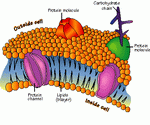|
Energy From Food – How Much Do We Need?Whether we think about it or not the reason we eat is to get energy from food. We cook those delicious meals to get energy from our food to fuel our body’s processes to carry out our daily tasks of living.
Energy is needed for muscle movement and for nerves to send and receive messages throughout the body. The three nutrient classes that are our energy sources carbohydrates, fats, and proteins in the order of usage, with carbohydrates being the first fuel source to be tapped first as glucose, a simple sugar, next are fats as triglycerides, then proteins.
Nutrients when taken in through food are broken down in a process called metabolism to produce energy in a form that the cells of the body can use.
But how do we measure the energy that is available to us in food in order to determine how much we need to run our body processes and to maintain good health? That energy in food is measured as the potential energy in food. The body’s use of energy is measured in units of heat called kilocalories where one kilocalorie equals 1,000 calories. This measurement can help us to determine how much energy we would need to fuel our daily activities. As part of determining how much food we need to consume to get the right amount of energy from it, scientists have found that carbohydrates and proteins yield 4 kilocalories for every gram of carbohydrates consumed and that fats yield 9 kilocalories for every gram of fat consumed.
Although the amount of energy that food yields is technically measured in kilocalories, common everyday usage refers to this measurement as calories, which is not really true, but has become the term used. So, it has now become popular to use calorie as a general term for energy and kilocalorie as the specific measurement or unit of energy. As a result food labels, diet books and other sources of nutrition information use the term calorie not kilocalorie.
Calculating The Energy From Foods There are some formulas that can be used for those that are counting how many grams of a particular food item they should eat to obtain a certain amount of energy. Formula #1: Grams carbohydrate x 4 kilocalories/gram = kilocalories + Grams protein x 4 kilocalories/gram = kilocalories + Grams fat x 9 kilocalories/gram = kilocalories ____________________________________________________ = Total kilocalories available from food For example let’s assume that we have a breakfast consisting of:
Applying the formula: 38 grams carbohydrate x 4 kilocalories/g = 152 kilocalories 18 grams protein x 4 kilocalories/g = 72 kilocalories 27 grams fat x 9 kilocalories/g = 243 kilocalories Total kilocalories = 467 kilocalories Formula #2: The second formula allows for the calculation of how much carbohydrates, proteins, and fats contribute to the total, that formula is: Gram carbohydrate x 4 kilocalories/gram = kilocalories/total kilocalories x 100 = % carbohydrate kilocalories Gram protein x 4 kilocalories/gram = kilocalories/total kilocalories x 100 = % protein kilocalories Gram fat x 9 kilocalories/gram = kilocalories/total kilocalories x 100 = % fat kilocalories The percent(%) contributed by each nutrient is: 38 grams carbohydrate x 4 kilocalories/g = 152 kilocalories/467 x 100 = 32.6% carbohydrate 18 grams protein x 4 kilocalories/g = 72 kilocalories/467 x 100 = 15.4% protein 27 grams fat x 9 kilocalories/g = 243 kilocalories/467 x 100 = 52% fat The Dietary Guidelines for Americans 2010 list the recommended percentages of carbohydrates, fats and proteins for various age groups as:
This is one way that we can cook those great recipes, obtain the energy from food that we need, maintain a healthy weight, and good health relatively free of disease by paying attention to how much of the nutrients from foods we include in our daily diet.
• Nutrition – Fourth Edition by Paul Insel, Don Ross, Kimberley McMahon, and Melissa Bernstein • Dietary Guidelines for Americans 2010 – www.dietaryguidelines.gov
Cooking Recipes
|







